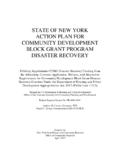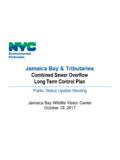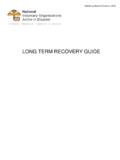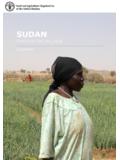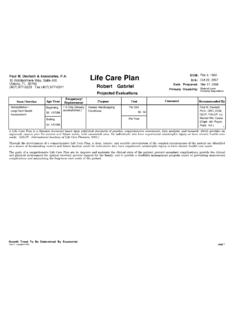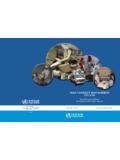Transcription of ACTORS IN DISASTER CYCLE, ANALYSIS OF SIX RECOVERY …
1 1 ACTORS IN DISASTER cycle , ANALYSIS OF SIX RECOVERY PLANS, and financial SOURCES FOR POST- DISASTER community RECOVERY EXECUTIVE SUMMARY To properly mitigate against, prepare for, respond to, and recover from disasters, it is crucial to know who is involved. In the Fall of 2014, fourteen Master s of Urban Planning students at Texas A&M University created this report as part of the graduate course DISASTER RECOVERY and Hazard Mitigation instructed by Yu Xiao, , AICP. The purpose of this report is to provide information on the four phases of the DISASTER cycle (mitigation, preparedness, response, and RECOVERY ), the critical tasks that need to be accomplished in each phase, and who needs to be involved in those tasks.
2 The processes involved in compiling this report is internet research on RECOVERY plans and sources for post- DISASTER community RECOVERY . We reviewed six RECOVERY plans and five cases studies for finding funding sources. Four of the plans are local community plans, and the others are state plans. We identified the steps to the long-term RECOVERY planning process, the leadership and stakeholders, and the outcomes. The six plans reviewed are: Cordova, Alabama, Fairfax, Virginia, Galveston, Texas, Greensburg, Kansas, New York, New York, and Lyons, Colorado. RECOVERY Plans There are two types of RECOVERY plans identified in our search: 1. Pre- DISASTER RECOVERY plan (PDRP), which are created before an event and focus on the transition from response to RECOVERY , coordination, and RECOVERY agency operation.
3 2. DISASTER RECOVERY plan (post-event), which describe the community visioning process after a specific event and identify particular activities to rebuild and renew the community from economic, natural resources, housing, and social services. This does not include discussion of RECOVERY Agency s, but instead taskforces to visioning and plan development. 1. Pre- DISASTER RECOVERY Plans Pre- DISASTER RECOVERY plans are rare, and we found one (Fairfax, Virginia). Fairfax officials described their document as such, By focusing on the Strategic and Concept levels, this PDRP provides a flexible and scaleable framework for organization and decision-making that may be effectively deployed against unknown and unpredictable threats particularly those of an intentional, human-caused nature.
4 The PDRP thus provides menus of potential options, depending on the scope and scale of an incident: potential roles of staff in a temporary RECOVERY Agency, potential issues and tasks that the RECOVERY organization may need to address, and potential lead and supporting agencies in RECOVERY Support Function roles. 2 The example PDRP includes sections that address: a. Visions, goals, and priorities i. Be prepared and proactive ii. Establish and maintain County s leadership role iii. Leverage private and nonprofit sectors using existing relationships iv. Promote legitimacy and credibility v. Focus on fairness vi. Build on existing plans vii. Ensure sufficient financial reserves b.
5 Post- DISASTER goals i. Effective command and coordination ii. Maximize funding iii. Communicate iv. Promote mitigation and resilience v. Maintain county economic base vi. Sustain social and human services vii. Provide and ensure quality housing viii. Sustain and restore infrastructure c. List of priorities in post- DISASTER context d. Hazard ANALYSIS (similar to what this class provided in the other report) e. Description of the RECOVERY Committee i. Structure, ii. Management, iii. Organization, iv. Reporting, and v. Leadership composition vi. Timeline vii. Functioning post-event f. Pre-event objectives i. Establish and maintain pre-incident coordination ii. Inventory resources and capacities, identify gaps iii.
6 Address issues in resource procurement iv. Maintain and promote continued capacities v. Train and exercise the PRDP g. Post-event objectives i. Brief supporting agencies ii. Identify and address resources needs iii. Identify additional funding needs and sources iv. Maintain documentation v. Maintain legal compliance vi. Ensure health and safety of RECOVERY staff Post-event RECOVERY Plans Post-event RECOVERY plans are all very similar and follow FEMA guidelines, and are often developed with a FEMA RECOVERY coordinator. These are created immediately following a DISASTER , as soon as possible. These documents describe: the DISASTER and impacts, the community pre-event, the public engagement process to develop the RECOVERY goals and plans, and 3 the resulting community Vision that came out of the public participation process.
7 Usually the participation process involves 5-10 public meetings. The RECOVERY community Vision is then detailed in specific projects, up to 40, which fall under broad themes, such as environment, economic, housing, health, transportation, green development, community character, education, etc. Projects can include creating new economic opportunity office, revitalizing expanding parks, etc. Each project will have a price assigned and also a list of potential revenue sources for it. This entire process is often led by specialists, such as academic, planning, or corporate consultants. This process is similar to what Texas Target Communities at Texas A&M would undertake in a community .
8 (see: ). Funding Sources In the United States, individual, local, and state financial resources are used first after a DISASTER , and then the federal government provides funding through various programs. Individual funds can come from personal savings, insurance, personal loans, and friends and family. Local funds can be from churches, non-profit organizations, insurance, and personal loans along with other sources that arise due to need after a DISASTER . State funds may be from various budgeted programs set aside for DISASTER RECOVERY and mitigation. Most of the major sources of RECOVERY funding for communities, businesses, non-profit organizations, and households after a DISASTER come from a few key agencies in the federal government.
9 RECOMMENDATIONS Assign a chair to each project the person in charge of the project as a whole. This person would be in charge of designating various assignments to those who are on the team for that project in particular. Having a chair for everyone to go to would facilitate the project getting completed in a timely manner. Elaborate on the community outreach efforts. Scheduling community meetings, creating a RECOVERY website that is user-friendly, and having open-house discussions that are well-advertised would help get community input and aid in prioritizing the RECOVERY projects. Develop a PDRP for the next event using the Fairfax, VA one as a guiding document. Questions or comments?
10 Contact: Michelle A. Meyer, Research Project Principal Investigator 218-791-8621 1 ACTORS in DISASTER cycle , ANALYSIS of Six RECOVERY Plans, and financial Sources for Post- DISASTER community RECOVERY Prepared by: Faisal Aldalbahi Tiffany Cousins Kristie Franks Nur Hamidah Kalen Herring Ridvan Kirimli Ricardo Maga Rojas Robert McCharen William Paiz-Tabash Ellen Phillips Jeewasmi Thapa Andrew Wallick Wenqian Yan Yixun Zhang Edited by: Maria Watson Instructor: Yu Xiao, , AICP plan 647- DISASTER RECOVERY and Hazard Mitigation 2 Department of Landscape Architecture& Urban Planning Texas A&M University Fall 2014 Table of Contents Part 1: ACTORS Involved in Each Phase of the DISASTER cycle 7 Part 2: RECOVERY Plans an ANALYSIS of Six Long-Term RECOVERY Plans Introduction.
